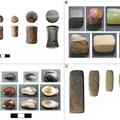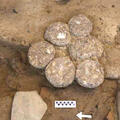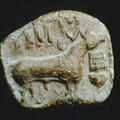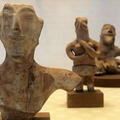An exceptionally interesting, data-driven paper that suggests much was unique about the ancient Indus weight system: "To determine how different units of weight emerged in different regions, researchers compared all the weight systems in use between Western Europe and the Indus Valley from 3,000-1,000 BC."
344 posts, also carried on our Facebook page, about the ancient Indus Valley civilization, including important news, research and occasional visits to museums with ancient Indus artifacts.
Jun 29, 2021
An Indian State Railways brochure advertising Mohenjo-daro from approximately 1935. With the full text of the brochure (figures, captions charts and images): "Until quite recently, India's wonderful and varied history seemed to spring straight out of nothingness—like the warriors that sprang full-armed from the dragon's teeth sown by Cadmus."
May 13, 2021
The ground-breaking Two Rains Project centered at Cambridge University is presenting a 7 event conference across 7 weeks online.
Apr 3, 2021
An audio interview with Dr. Jonathan Mark Kenoyer with Wisconsin Public Radio explores his work and discoveries at Harappa, where stone tools suggest the area was inhabited as early as 10,000 BCE. An fine hour of highlights and key finds around crops, animals and culture and evidence for the earliest curries and writing.
Mar 27, 2021
An exciting find, not only because this is the first foodstuff preserved in such excellent condition, but also for the continuity with today, is this Times of India article on multi-grain, high-protein laddos found at the 4MSR site in Rajasthan on the border with Pakistan.
Mar 7, 2021
A stunning VW Bug by the Pakistani folk artist Haider Ali in Sindh.
Jan 26, 2021
"Sealing or token with impression made from a unicorn seal with script. The back is smooth and rounded, suggesting that this object was a certificate or pass representing the seal owner and not something attached to a bundle of goods.
Nov 3, 2020
A Wide World Photo news agency photograph with the title given above was dated June 4, 1959. The caption, reflecting then popular conceptions like "invaders," was printed on the back:
"For three thousand years a great and peaceful civilization has lain
Jul 21, 2020
"This terracotta vessel with a pronounced knob at the centre has engaged the attention of archaeologists as a "unique find" and was probably used in rituals or ceremonies. Similar vessels have been depicted on Harappan seals and copper plates" according to the ASI description of this object found at Bijnor (MSR 4) in 2017.
Jun 19, 2020
A brand new slide show has just been opened featuring objects from Mundigak, a little-known Bronze Age [c. 4000-2400 BCE] set of mounds in southern Afghanistan. The objects are now at the Guimet, the French National Museum of Asian Art in Paris.
Jun 4, 2020
In the summer of 2019, one of the warmest ever in Paris, I managed to slip one afternoon into the Musee Guimet, and click away on my iPhone at objects usually not seen in colour. This French national museum which contains one of the best collections of Asian Art in the world (as one collector of Indian art, Gursharan Sidhu once put it, the French taste in objects from India is second to none).
Apr 27, 2020
Was this disc from Mohenjo-daro at the National Museum of Pakistan in Karachi used for counting? The circles with dots in the middle are identical to those found on other ivory objects from Mohenjo-daro thought to have been used as counters.
Jan 16, 2020
Etched carnelian beads are a hallmark of the Harappan phase and copies of them in different materials are found during this period illustrating their value to the people of the Indus Valley Civilization. Examples of this bead type have also been found in Mesopotamia, Iran and the Gulf and it is believed now that all of these may have been manufactured in the Indus Valley.
Jan 14, 2020
A visit to the National Museum of Pakistan in Karachi gave me the opportunity to take close shots of four seals from Mohenjo-daro. They show both the exquisite workmanship of Indus craftsmen and the merciless wear, in different degrees, of four thousand years of history.
Dec 17, 2019
On a visit earlier in 2019 to the National Museum of Pakistan in Karachi, an iPhone camera was a welcome companion in trying to bring out something of the character of Indus figurines resident within the large glass vitrines.















